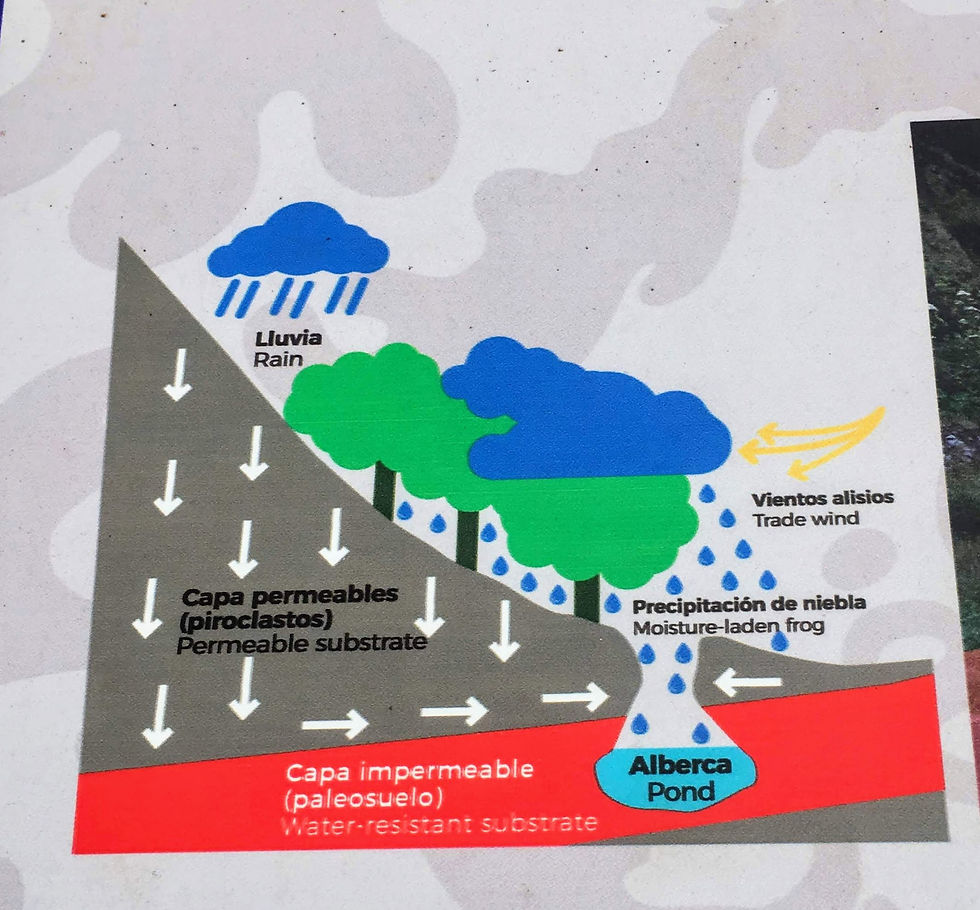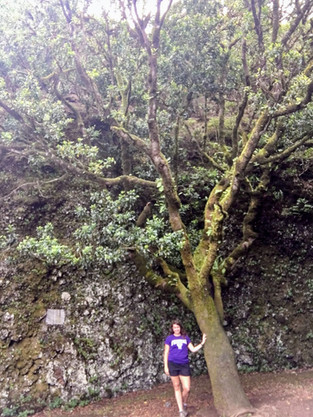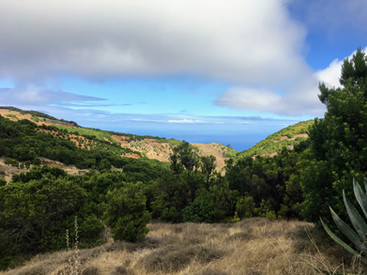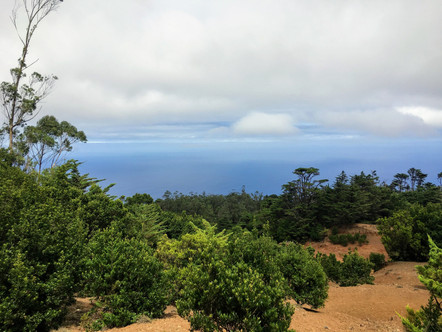Journey to the Sacred Tree
- Sadie Williams

- Nov 1, 2018
- 6 min read
"Water has always been a rare good on El Hierro."
A couple weeks ago, I hiked to the Garóe Tree, el Árbol Garóe, the sacred tree of the ancient peoples of El Hierro. It was quite a journey and I saw all sorts of different environments on the island! Read on to learn more about this amazing tree.
I started by taking the bus from Valverde, about 20 minutes to the town of San Andrés. We drove past the windmills, through a foggy evergreen forest, and arrived at a little bus stop next to a cute little church and a farm with a bunch of cows, sheep, goats, and chickens all mooing, bleating, and clucking at me to provide food. Sorry friends! :) I started walking along a dirt road, following the handy-dandy trail signs depicting the tree. I was walking the Ruta del Agua, the Route of Water, which follows the ancient path to the main source of fresh drinking water on the island.
It led me through a dry coniferous forest, covered with leaves and dry pine needles. It was cloudly and quite windy, but I was thankful it wasn't too hot for a hike! I passed some neat cacti and I saw two very interesting dry trees on my way up the hill. I also met some free-range cows and horses!
I continued up the dirt road and over the edge of a hill where I could see a stunning glimpse of the ocean. After about an hour and a half of walking from San Andrés, I arrived at the Centro de Interpretación de Árbol Garóe, the Visitor Center where I bought a passport that lets me get into all of the seven cultural centers and museums on the island. Then I headed down the little path to see the famed tree, the symbol of El Hierro!
The Legend of the Tree
The Garóe tree is the symbol of El Hierro (seen in the coat of arms) and, according to legend, filtered water from the clouds. Garóe meant the one specific tree, not just a type of tree, since it was able to provide fresh water due to both its leaves and strategic location.

I learned about two interesting legends surrounding the Garóe tree at the Centro de Interpretación. Both took place in the 15th and 16th centuries in the wake of the Spanish conquest and settlement. According to the sign I read, the legends "tell of wondrous events full of mystery, passion, intrigue, and upheaval of a bygone era" and "witness the vanishing of the [indigenous peoples, the Bimbapens] and the decline of their culture." They also both describe forbidden love.
The first legend dates back to 1597 and is sometimes called "The Mystery of the Water Tree". When the Spanish first arrived, one creative and clever strategy that local people used to keep them from successfully conquering the island was refusing to reveal the secret of finding fresh drinking water.
"The legend revolves around a resistance plan forged by the Bimpabens, full of secret complicity and aimed to dissuade the unsuspecting intruders from their intention to settle on the island. The [key] to succeed in this plan was thirst: the secret of water production was hidden to the occupying forces. The Garóe tree was carefully camouflaged with twigs and branches to make it invisible."
Unfortunately, a native woman name Agarafe or Guarazoca (depending on who you ask) fell in love with a Spanish soldier and betrayed the secret of the tree. For her betrayal, she paid with her life.
The second legend has been passed down by oral tradition and describes the loss of the original Garóe tree in 1601. After the Spanish conquest, there was a young and ravishingly beautiful princess named Teseide living in the last refuge of the indigenous population, growing up under the supervision of "respectable old men". These men saw in Teseide an opportunity to secure the survival of the Bimbapens and arranged her marriage to a brave warrior named Taboldón. However, Princess Teseide fell in love with Fernando Espinosa de Herrera, the son of a rich Spaniard living in El Hierro. Their love was forbidden, but they continued to meet in secret anyway. Eventually, the warrior Taboldón discovered the affair and killed the Spaniard, Fernando.
Teseide was driven mad from grief and, "mad, frantic, and full of pain, she rushed to the abyss of Letime de Bascos and jumped into the depth. Provoked by her death, a heavy storm uprooted the Garóe tree. Hence was sealed the end of the Bimbapen people of El Hierro after 1,500 years as masters of their own destiny there."
The tree that is there now is still stunning, nestled in a little cove and surrounded by hidden underground reservoirs and ponds dripping with lily pads, ferns, and moss.
The Science of the Tree
The island of El Hierro is the youngest, smallest, and most southwestern island in the archipelago of the Canary Islands. It is estimated to be 1.7 million years old (just a baby!) and is 268.7 square kilometers, with its highest elevation being 1,501 meters above sea level (almost 5,000 feet). El Hierro is also notable for its very few water sources. There are no rivers, fountains, or springs near the coast. The island also only gets irregular rainfall, caused by clouds, fog, and mist brought by northeast trade winds. Because of this, getting fresh water has been a very real problem for thousands of years. The Garóe tree answered this problem for the ancient indigenous peoples, the Bimbapens.

The Garóe tree is located in the area of Los Lomos, on a slope of the Ventejís volcanic cone (880,000 years old!) The ground surrounding the tree is made up of impermeable clay, soil from recent volcanic eruptions, and porous soil on top of the other types of earth. This means that, when fog filled with moisture rises up through the ravine, it gathers into trenches and small underground ponds at the base of the tree, allowing people to collect that fresh water. Native peoples were able to take advantage of this "horizontal rain" -- the ability of air to store humidity and transform it into water via condensation and contact with plant life.
"There are other wells, the most important being a tree which distills water, day and night, for the residents and their livestock. This tree is located in a place call "Tigulahe" by the locals. The tree is also called "Garóe" or "Holy Tree" as it seems to be a wonderful and supernatural thing." - Abreu Galindo, a monk, 1602
Archeological studies confirm that the Bimbapens became experts in architecture, manufacturing tools, setting up burial sites, and in digging a system of pits and cavities used as hearths for cooking and preparing food. They also constructed small reservoirs and ponds to collect the fresh water, delivering water during droughts.
"On the highest parts of [El Hierro] there are trees from which delicious and clear water is dripping off permanently. It is collected in pools in the immediate vicinity thereof being the most exquisite drinking water." - French-Norman conquerors, 15th century
After the Spanish colonization, water pits were improved and enlarged and the supply of drinking water for the people and their livestock was secured for centuries. The tree itself plays a decisive role because of its lush and dense branches and its abundant, healthy evergreen foliage.
Although the original tree disappeared due to a hurricane in the 17th century (as per the legend above) its significance survived in the memory of local peoples and a new tree was planted in remembrance in 1949. It is amazing that the significance of the tree is still so well-known on the island, since it was missing for so long.
La Ruta del Agua
After I left the tree, I continued on the Route of Water back home to Valverde. For much of the time, I saw breathtaking views of the ocean over the mountains.
I also found myself in a rainforest, covered with mossy trees, a thick foliage, and ferns. All the moss grew on one side, so perhaps I could navigate with it!
After emerging from the humid rainforest, I found myself walking through red sand, still overlooking the sea. It reminded me a lot of Southern Utah. It was so cool to walk through so many different ecosystems in my short half-day hike!
An inspiring quote from the Visitor's Center:
"The message of the Garóe for the 21st century - a tree that allowed the survival of our ancestors, who possessed less technological means than those existing today - is a warning to a better treatment of our resources in accordance with the environment. This is the only way to safeguard the livelihood of future generations."

¡Hasta la próxima!




































































































Comments